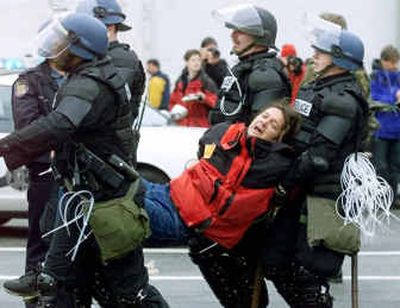Seattle’s no-protest zone upheld

SEATTLE – The city had a right to block off part of downtown Seattle when World Trade Organization protests turned violent in 1999, a federal appeals court panel ruled Thursday. But the judges said the city may have gone too far in targeting only anti-WTO protesters within the restricted zone.
The ruling partially overturned a 2001 decision by U.S. District Judge Barbara Rothstein, and it means that some demonstrators may pursue a class-action claim that the city violated their constitutional rights.
In late 1999, some 50,000 people swarmed downtown Seattle in protest of a WTO meeting. A relatively small number of protesters smashed storefronts and overwhelmed police, who responded with tear gas and mass arrests. Damage totaled about $2.5 million.
Part of the city’s response was to impose a curfew and declare a “no protest” zone around the downtown core: WTO delegates or staff, downtown workers and shoppers were the only people allowed into the zone.
Some people were arrested for protesting in the zone. Others were barred from entering the restricted zone – even if they were on their way to work or shop – because they were wearing “No WTO” stickers or signs.
Several protesters sued in federal court, arguing that the city had no right to suppress lawful speech in response to the actions of a few bad apples. But Rothstein threw out their claims, saying the city had imposed a proper “time, place or manner” restriction to ensure public safety.
On Thursday, a panel of the 9th U.S. Circuit Court of Appeals agreed 2-1 that the city had a right to create the “no-protest” zone.
But all three judges said in the 109-page opinion that the way the zone was enforced – by arresting anti-WTO protesters alone – raised serious questions about discrimination. The effect of the city’s actions may have been to target only speech of a certain viewpoint – something prohibited by the First Amendment, the judges said.
The panel sent the case back to U.S. District Court for trial on that matter.
“While respecting the liberty of protesters, a city must be permitted to act reasonably, within the bounds of the Constitution, to fulfill its responsibilities of providing physical security and the maintenance of order that is required for all of a city’s residents and visitors,” Judge Ronald M. Gould wrote for the majority.
“However,” Gould went on to say, “viewing the evidence in the light most favorable to appellants, in some instances police conduct may have gone too far and infringed on certain individual protesters’ constitutional rights by making the content of their expressed views the test for their entry into the restricted zone.”
The case reviewed by the panel was a consolidation of two earlier cases, each brought against the city by protesters arrested in the restricted zone.
Arthur Bryant, an attorney with Trial Lawyers for Public Justice, which represented some of the protesters, called the decision “both a great victory and a great loss”: a great victory because the judges found the no-protest order may have been unfairly applied, and a great loss because the judges ruled that it is constitutional for a city to broadly suppress lawful speech in response to the violent actions of a few.
The 135-nation WTO sets rules for world trade. Protesters claimed the organization promotes international commerce at the expense of human rights, labor protections and the environment.